19 Uses for Dental Floss (Besides Flossing Your Teeth)
You probably have a roll or two of it in your bathroom. You know, in that drawer in the vanity that has the old razor you haven’t used in months, the cord for a shaver that broke last year, several band-aids and various tubes of ointments (most likely half of them are expired). I’m talking about dental floss (Duh, didn’t you see the title).
Dental Floss for Survival Use
Well, that roll of dental floss can be used for a lot more than getting that chunk of steak fat from between those two back molars. It actually has a lot of uses, and since a roll is so small you can stash one (or four) in your bug out bag for in case of emergencies. Not only can dental floss can be an indispensable addition to your BOB (especially considering a 140 yd roll of mint waxed is only $1 at the Dollar general Stores), but keeping one in the car for emergencies can be a good idea as well.
Now the minty flavored part is irrelevant, but being waxed helps it stay dry and makes it easier for uses like stitching leather. I regularly use un-waxed dental floss to stitch leather, but I used un-waxed so it will take the dye. When I dye the object I have made, and besides, I am going to rub beeswax on it when it’s finished anyway. But for use as an emergency string, I would opt for the waxedtype because that makes it water proof.
Widget not in any sidebars
Starting Small
So let’s look at some uses for dental floss in an emergency situation. Think of it as synthetic sinew, it can do everything sinew can do and so much more. The first thought that comes to mind is using dental floss as fishing line, and I have actually used it for that before when I was a kid and I successfully caught several bluegill with it.
But keep in mind that dental floss doesn’t have the stretch, or elasticity, of real fishing line, so a single strand may not be strong enough for bigger fish. But it will work in a pinch because you can braid it and make stronger line if need be.
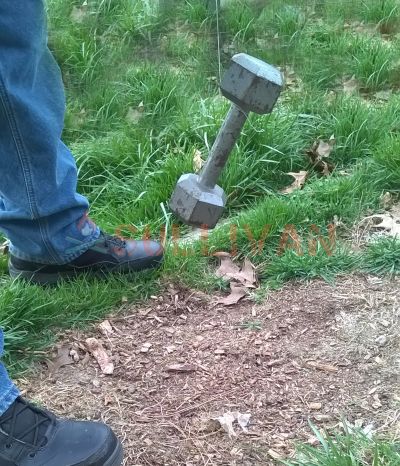
Tensile Strength
I tested a piece for this article just to get an idea of the tensile strength, and one single strand broke before it was able to lift a ten pound weight off the ground.
But when I doubled it, not braided or twisted or anything mind you, just two strands of floss, and then it was able to lift the ten pound weight off the ground. I lifted it several times to see if it would break but it held.
Let’s Do the Twist (or Braid)
Here is something interesting to note, when I tried to twist two strands of it together, like you do when twisting twine from fibers, it did NOT stay together. I’m not sure why, but it just wouldn’t hold the twist. However, when I braided three strands together it braided very nicely and held a tight braid.
I’m not sure of the physics behind it, but if one strand holds, let’s just say 5 pounds for the sake of easy math, when you twist or braid the same strands together it becomes exponentially stronger. As in if one strand holds 5 pounds, three strands braided will hold maybe 20 pounds. I read a story about a convict using a 48 strand dental floss rope to escape and it succeeded in supporting a 155 pound man.
Braiding String
Keep in mind that braiding string as fine as dental floss is going to take some time to get any kind of length, but if you’re stranded or lost and need stronger than one strand (like for a bowstring), you have plenty of time to braid it. To braid dental floss, (or any string really), tie the three loose ends together, and then tie that to a twig on a tree to hold it for you (like in the video showing me braiding floss, below).
If you have a lot to braid you may want to sit and do it rather than stand, in which case cut a stick from the tree and hold the stick with your feet while you braid. Braiding is simple so if you’ve never done it have no fear. You have three strands, left, center, right, but that’s not the individual strands, it’s the position of the strands. Left, center, and right strings change their position constantly as you braid.
All you have to do is start from either side (let’s say left for the sake of the example), and go over the center, now that string you just moved becomes the center string. Then you move the right string over the center string, now the right string is the center string. Then you just keep moving the left and right strings over the center string, pulling it tight as you go.
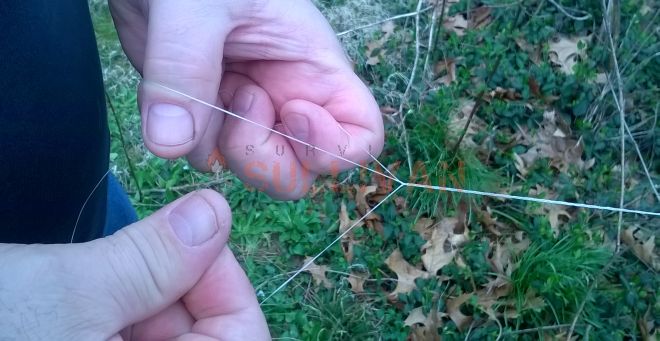
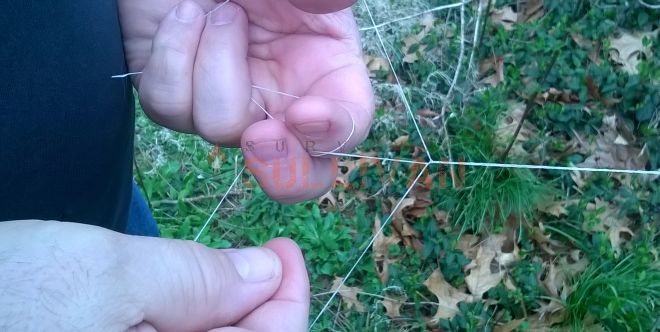
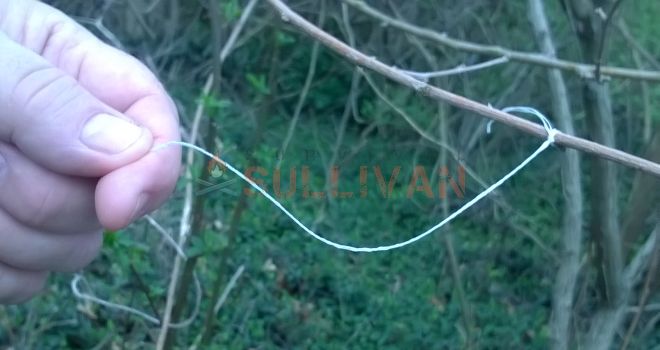
If you need a really heavy cord you can braid three smaller strands to make a thicker strand, then use those braided cords to braid again and make an even thicker cord. That will make a 9 strand braided cord, it would be pretty strong. The same works with twisting cord too. With twisting cord you only use two strands, you twist them together to make a thicker strand, and then use two of those twisted strands to twist into an even thicker cord and so on.
Strong Little String
Dental floss is actually very strong considering how thin it is. I read a news story talking about how prisoners used dental floss to make garrotes to kill other prisoners with. One story told how some prisoners had collected about 18,000 feet of dental floss and braided it into ropes and escaped over the wall with it!
Dental floss is also supposed to have been used to cut through the bars of a cell to afford a prisoner’s escape. He used it with an abrasive material and painstakingly cut through the bars over an extended period of time.
Dental floss has basically become a problematic material in prisons and so subsequently it has been banned. Instead, prisoners are now only allowed “safety floss” loops or the little plastic sticks with a bit of floss on the end. There’s another story of an inmate escaping with a dental floss rope made from just 48 strands of floss.
Here’s a video discussing dental floss use in prisons:
Uses for Dental Floss in Survival Situations
- Fishing line
- Stitching leather
- Mending clothing
- Shoe strings
- Clothes line (single strand for socks and undies)
- Cordage
- Fire starting
- Cutting soft objects like meat, fruit, and vegetables
- Sutures
- Bow string (for hunting bow or bow drill)
- Bindings (sticks for making useful objects like lean to etc.)
- Lashings (arrow heads/spear points)
- Handle wrap on tools and weapons (the wax makes it slip resistant)
- Trip line (for camp alarms and booby traps)
- Garrote (choking cord)
- Snare line
- Whip rope (tie the ends so it doesn’t unravel)
- Making a net
- Repair eye glasses in a pinch by lacing through the screw hole
- Umm, floss your teeth. Just because you’re lost doesn’t mean you can forego proper hygiene.
Making a Simple Bow String
To make a bow string for a hunting bow from dental floss is actually very simple. Once you have made the bow (I’m just using an old 30# fiberglass bow), you will want to make the bowstring at least two inches shorter than the bow.
#1. Make a couple of fairly sturdy stakes:
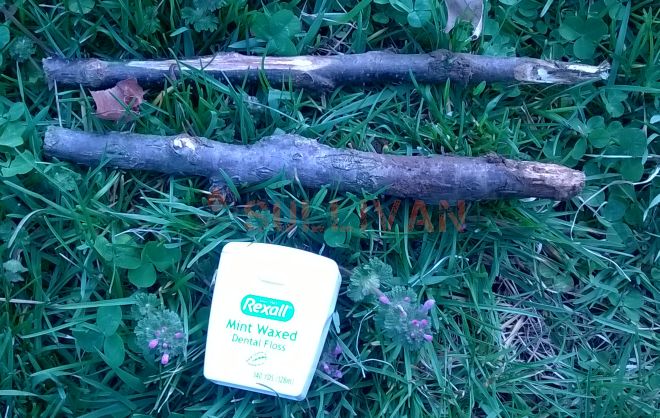
#2. Drive them in the ground a few inches shorter apart than the bow:

#3. Tie a loop on one end of the dental floss the desired size of the final loop in the bowstring. Loop that over one of the stakes in the ground and then go around the stakes several times with the floss.

The thickness needed of the bow string depends on the draw weight of the bow you have made. A bowstring for a hunting bow will probably need at  least a dozen or so strands to withstand the weight of the bows draw. If one strand held 5 pounds of dead weight, a dozen strands should theoretically withstand a 60 pound draw weight bow. I made this one 12 strands thick for a 30# bow.
least a dozen or so strands to withstand the weight of the bows draw. If one strand held 5 pounds of dead weight, a dozen strands should theoretically withstand a 60 pound draw weight bow. I made this one 12 strands thick for a 30# bow.

A bowstring for a bow drill will probably be fine with just 6 or 8strands, I would braid them for a bow drill string. Although if I were making a bow string for a bow that I needed to hunt with to get food, I personally would opt to over build it to make sure it doesn’t break. When you get to the final strand, tie it around the stick in a loop the same size as the first one you made.
#4. Now take the floss and come about 1 1/2″ from the end of your string and whip the bow string. Wrap each end with more floss for at least 1/2″ (an inch is better, depending on how much floss you have) to make a loop for the nock on the end of the bow.
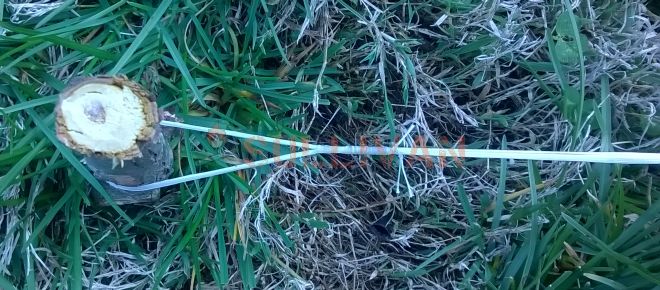
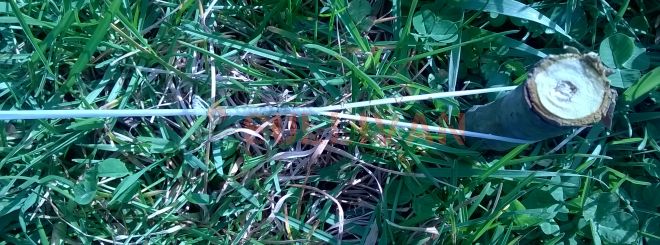
#5. Now find the center of the bow string and go two to four inches away from the center and wrap the bow string with floss all the way to two to four inches past the center. This is called “serving” the bow string (although I’m not sure why it’s called that). This strengthens the bow string where you will have to nock the arrows and keep it from fraying and breaking.
Here’s a video showing a guy serving a bow string:
Here’s another video showing it done by hand:

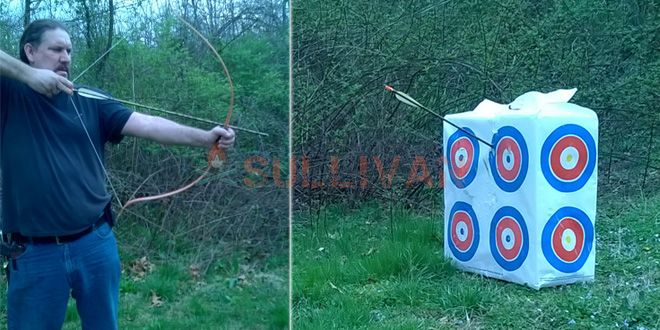
Bind Arrowheads and Fletching
Now that you have made a bow and bowstring, you will need arrows. Once you have made the arrow shaft, you can use some dental floss to lash the fletching (feathers) to the shaft. Position the fletching so that the lashing also binds the nock (an arrow nock is the notch at the back of the arrow that goes on the string), to prevent the arrow shaft from splitting. You can also lash the arrowhead to the shaft as well using dental floss. Using dental floss in this manner will make a very strong arrow.
Making a Snare Line
When making a snare line from dental floss I would strongly suggest that you use a braided strand. A braided strand, while requiring more floss and time, will be much stronger and less likely to break should you get a five pound rabbit jumping and jerking on it before you get to him. Braid three strands of floss to make the needed length of cord for a snare, 2 feet is usually sufficient for a snare cord.
When you make a snare, tie one end to a sturdy stick that you will use to stake the snare to the ground. Tie a loop on the other end of the string to make the slip loop with. Then find a couple of thin sticks with forks in them to use to hold the snare open in front of a rabbit hole or what have you. The snare/sticks can be reused multiple times.
Fire Starting
Waxed dental floss is excellent for starting a fire because the wax acts as a fuel and helps the kindling sticks burn more readily. For best results wrap some dry kindling sticks with the floss. In damper conditions, wrapping a kindling stick thickly with waxed floss may help get the fire going faster. You can also make a kindling bundle by wrapping a few dry kindling sticks around some cat tail fluff with the dental floss. These will catch quickly.
Shoe Strings
Of course dental floss is too thin with only one strand, but by using multiple strands (braided for best results), you can make a replacement shoe string stronger than the original. If your boot lace merely broke but you still have it, then you can repair it by wrapping floss around the ends to lash it back together.
Whipping Rope
To keep your rope from unravelling you can tie the ends with floss, this is called whipping the rope. You can see by the pictures it isn’t hard to do. Just run the floss along the last inch and then wrap it back over itself. Then when you have enough of the end wrapped all you have to do then is just tie the loose ends off. Cut off the frayed ends of the rope and you’re done:
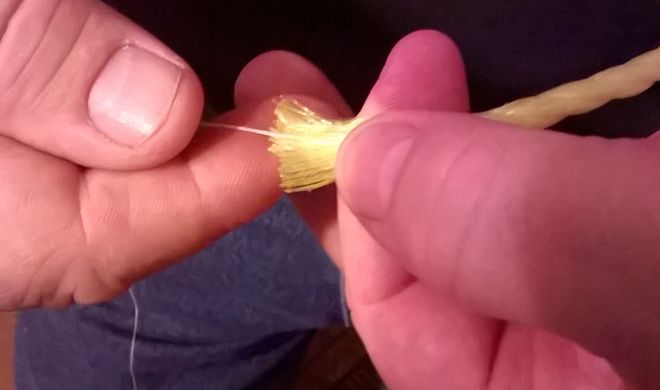
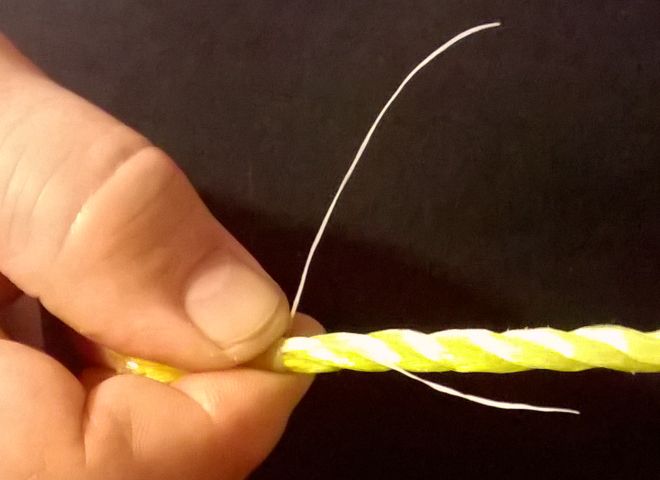
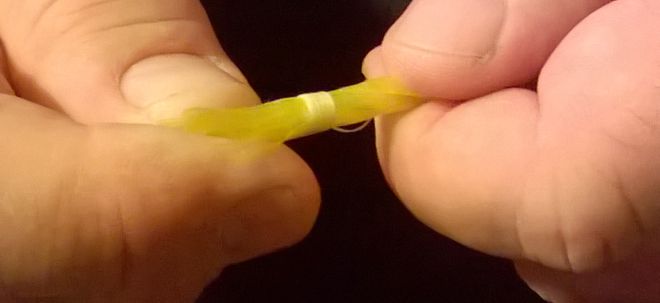
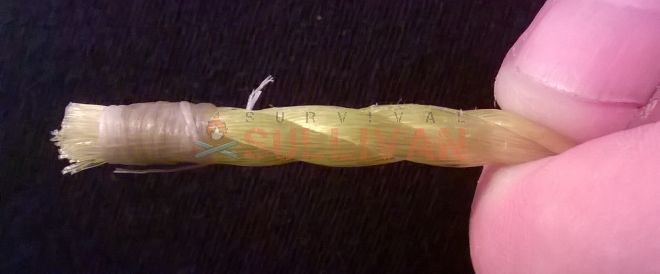
Wrapping it Up (With Floss)
Well, again, like I always say, if you should find yourself in a survival situation you must be able to think outside the box and utilize the materials at your disposal to achieve many things. If one of the materials you have happens to be dental floss you can actually accomplish a great deal with it. But do try to save a bit to actually floss with.
This article [19 Uses for Dental Floss (Besides Flossing Teeth)] originally appeared on Survival Sullivan and appears on Natural Blaze with permission.
Get their free eBook and like them on Facebook!
Read more features by Survival Sullivan
Eric Eichenberger is an avid outdoorsman, skilled marksman, and former certified range officer and instructor with nearly 40 years experience handling and repairing firearms. A skilled craftsman with a strong love for working with his hands, Eric spent 20 years as a carpenter and custom woodworker in high end homes. As a gold and silversmith he has created hundreds of pieces of jewelry over the years using the lost wax casting method. The grandson of humble country folk, he was raised with the “do it yourself” mentality and so is accustomed to coming up with unique solutions to problems utilizing materials at hand. Later in life Eric went on to earn an AA from Elizabethtown Community and Technical College where he is a member of the Phi Theta Kappa honors society. This was followed by earning his BA/psychology from Western Kentucky University where he was invited to join the Psi Chi honors society. Eric is also an associate member of the KPA (Kentucky Psychological Association). It was during his time as a student of psychology that he discovered his passion for writing. He has 2 gun-related books slated for a summer release.




